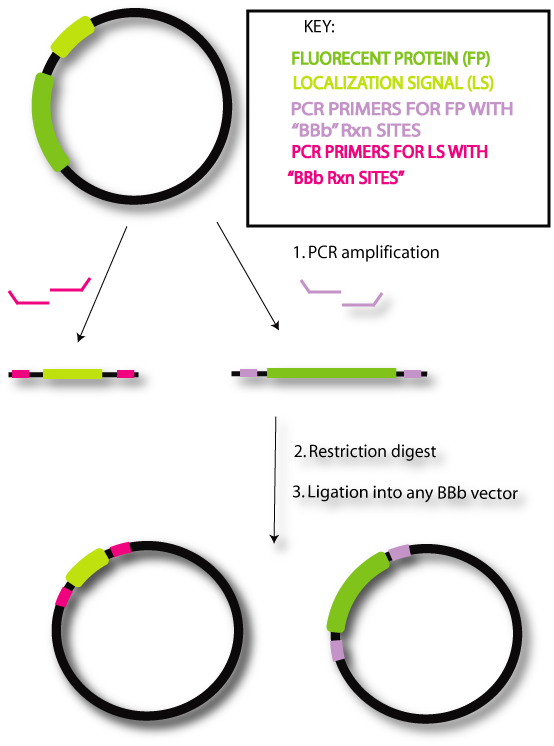Team:Heidelberg/Notebook color output
From 2009.igem.org
(→Multi-color Output Notebook) |
(→Multi-color Output Notebook) |
||
| (4 intermediate revisions not shown) | |||
| Line 6: | Line 6: | ||
|width="650px" style="padding: 0 15px 15px 20px; background-color:#ede8e2"| | |width="650px" style="padding: 0 15px 15px 20px; background-color:#ede8e2"| | ||
__NOTOC__ | __NOTOC__ | ||
| - | + | ='''Multi-color Output Notebook'''= | |
| - | + | ||
| - | + | ||
Please read the detailed [[Team:Heidelberg/Notebook_color_output_nb| Notebook]]. | Please read the detailed [[Team:Heidelberg/Notebook_color_output_nb| Notebook]]. | ||
| Line 16: | Line 14: | ||
[[image:FP_LS_cloning.png|center|thumb|400px|'''Cloning strategy used for FP and LS''']] | [[image:FP_LS_cloning.png|center|thumb|400px|'''Cloning strategy used for FP and LS''']] | ||
| + | Plasmids containing the fluorecent proteins (FPs) of interest and their localization signals (LSs) where provided as a curtsy of the [http://www.bioquant.uni-heidelberg.de/research/groups/screening_of_cellular_networks/home.html Starkuviene lab] and Dr. Joel Beaudouin of [http://www.dkfz.de/tbi/projects/modellingAndSimulationOfCelluarSystems/signalTransduction.jsp the simulation and and modeling division in iBioS], followed by: | ||
| + | *Designing the appropriate primers, with the correct Biobrick-β (BBb) prefix (on the Fwd) and suffix as non-complementary segments the FPs. | ||
| + | *PCR amplification of FP and LS. | ||
| + | *Restriction of the the amplicons with the appropriate enzymes and their insertion into the integration plasmid (link to integration plasmid) as follows: | ||
| + | When assembling promoter, localization sequence,flourescent protein and a polyA inducing sequence using the BBb standard assembly there are two possibilities to combine each two parts. This is dependent on which one is going to be used as part of the backbone and which one is to be the insert. | ||
| + | If you want to use the ''plasmid of the prefix'' (in sense of reading frame) as the backbone it is cut it with NheI and PstI while the ''suffix'' (which is the insert) is cut with SpeI and PstI. Ligating them as such allows the sticky ends of SpeI and NheI to ligate and form an uncuttable scar, while the PstI ends ligate to circularize the plasmid in its new build. | ||
| + | In case of using the ''suffix'' as part of the backbone, its plasmid is cut with EcoRI and SpeI. The ''prefix''– in this case the insert –is cut with EcoRI and NheI. The resulting constructs could be used for further the combination of further parts. Therefore the assembly of four parts only needs two steps of cloning. | ||
|width="250px" style="padding: 0 20px 15px 15px; background-color:#d8d5d0"| | |width="250px" style="padding: 0 20px 15px 15px; background-color:#d8d5d0"| | ||
|} | |} | ||
Latest revision as of 22:46, 21 October 2009
Multi-color Output NotebookPlease read the detailed Notebook. Cloning StrategyPlasmids containing the fluorecent proteins (FPs) of interest and their localization signals (LSs) where provided as a curtsy of the [http://www.bioquant.uni-heidelberg.de/research/groups/screening_of_cellular_networks/home.html Starkuviene lab] and Dr. Joel Beaudouin of [http://www.dkfz.de/tbi/projects/modellingAndSimulationOfCelluarSystems/signalTransduction.jsp the simulation and and modeling division in iBioS], followed by:
When assembling promoter, localization sequence,flourescent protein and a polyA inducing sequence using the BBb standard assembly there are two possibilities to combine each two parts. This is dependent on which one is going to be used as part of the backbone and which one is to be the insert. If you want to use the plasmid of the prefix (in sense of reading frame) as the backbone it is cut it with NheI and PstI while the suffix (which is the insert) is cut with SpeI and PstI. Ligating them as such allows the sticky ends of SpeI and NheI to ligate and form an uncuttable scar, while the PstI ends ligate to circularize the plasmid in its new build. In case of using the suffix as part of the backbone, its plasmid is cut with EcoRI and SpeI. The prefix– in this case the insert –is cut with EcoRI and NheI. The resulting constructs could be used for further the combination of further parts. Therefore the assembly of four parts only needs two steps of cloning. |
 "
"
